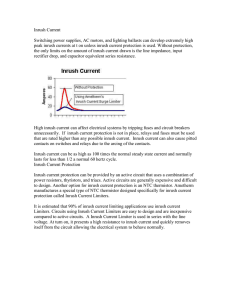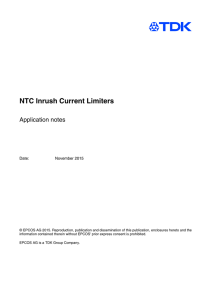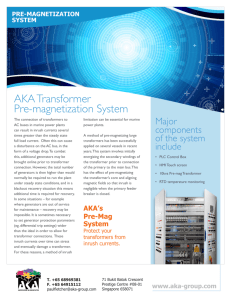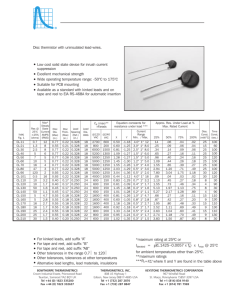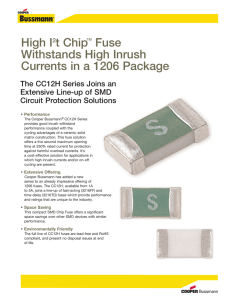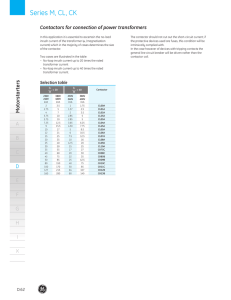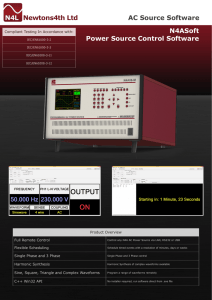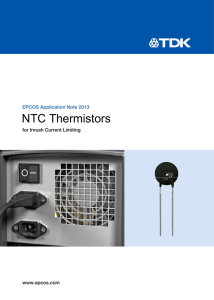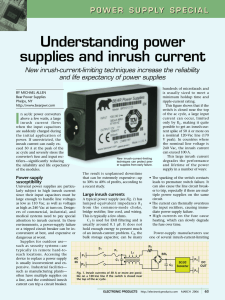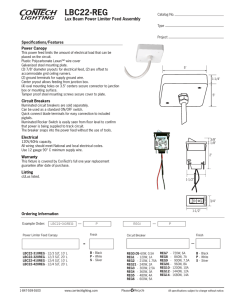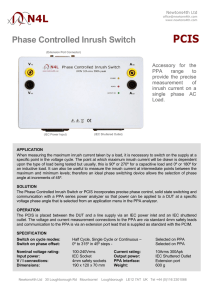NTC-Based Inrush Current Limiters
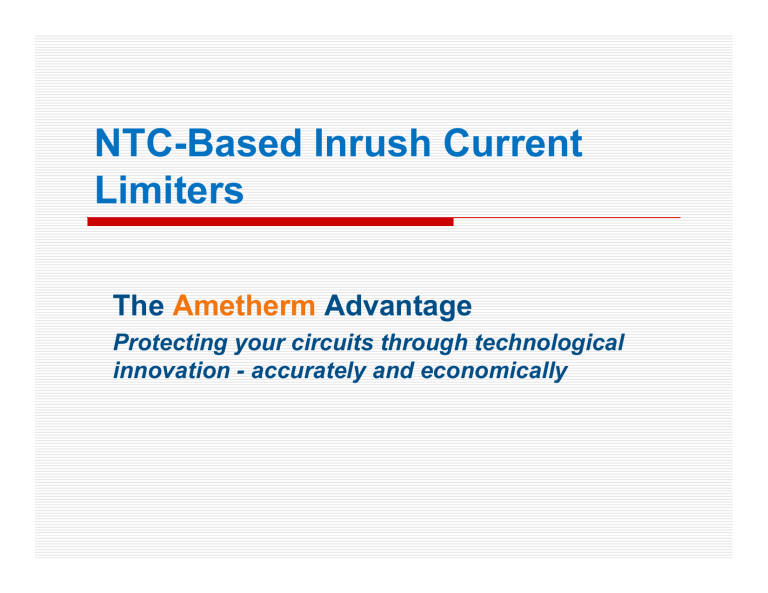
NTC-Based Inrush Current
Limiters
The Ametherm Advantage
Protecting your circuits through technological innovation - accurately and economically
What is Inrush Current?
hen you first turn on an electrical device, the maximum, instantaneous input current drawn by the electrical device is called the Inrush Current.
This current is also called input surge current. It is basically the charging current of the capacitance inside the equipment.
xample:
ncandescent light bulbs – draw large currents until their filaments warm up
C electric motors - draw several times their normal full loads current when first energized
ower converters – draw high inrush current relative to their steady currents
2
What is Inrush Current?
Inrush current is the maximum, instantaneous input current drawn by an electrical device, when the device is turned on.
3
Why Do You Need to Limit
Inrush Current?
nrush current can damage components when any equipment is turned on.
f steps are not taken to minimize this inrush current, it can damage power devices and reduce equipment life. ow Do You Limit Inrush Current?
here are two ways to limit inrush current:
sing NTC Thermistor-based inrush current limiters
sing various forms of active circuits - including triacs, power resistors, and thyristors
4 he exact solution for your particular application depends on component
About NTC Thermistors
Thermistors are electronic components that are used for temperature sensing, or to detect changes in the temperature of an object
Thermistors can detect very small changes in temperature through the manifestation of a big change in resistance (i.e., a nonlinear characteristics).
Thermistors are also tough, reliable and easy to use.
A Negative Temperature Coefficient or an NTC Thermistor is capable of lowering its resistance when there is an increase in the temperature of a measuring object.
NTC Thermistor exhibits nonlinear behavior. For example, if the temperature of a measuring object increases because of some internal heating the resistance of a working (engaged for this purpose) NTC
Thermistor decreases nonlinearly to indicate this increase in temperature.
5
NTC-Based Inrush Current
Limiters – How Do They Work?
NTC Thermistor based Inrush current limiter is one of the most common design options for protecting circuits is several applications.
The resistance of a such surge limiting thermistor decreases as its temperature increases. As the inrush current limiter self-heats, the current begins to flow through it.
Its resistance begins to drop and a relatively small current flow charges the capacitors in the power supply. After the capacitors in the power supply become charged, the self heated inrush current limiter offers little resistance in the circuit. So low that the voltage drop is an insignificant factor with respect to the total voltage drop of the circuit.
6
Advantages of NTC Thermistor-
Based Inrush Current Limiters
Lower component costs. inrush current limiters are typically less expensive than active circuit components.
Example: Typical cost of two Thermistors needed for a 300W power supply: $.80 or less for both thermistors.
Simpler design. Because inrush current limiter-based surge suppression circuits designs typically involve fewer components, they are less complex than those involving active circuits. In turn, a simpler design reduces the design time
Greater manufacturing simplicity and lower reject rates. Fewer components means fewer assembly steps.
Requires significantly less space on the power supply circuit board.
Commonly replaces a power resistor, relay and contactor or triac or thyristor.
(NTC- Thermistor based) Inrush current limiter-based surge suppression is self-protecting in the failure mode (no component replacement)
7
Ametherm NTC Thermistors –
Inrush Current Limiters
Two Series: SL (Surge Limiter) & MS (MegaSurge) Series.
Again, SL Series Thermistors are of three types: miniAmp,
Standard and bigAmp.
SL Series
- miniAmp
• Up to 20
Amps
• 2.5 to 220 Ω
• Up to 20
Joules
• Short Lead time
SL Series -
Standard
• Up to 20
Amps
• 0.5 to 220 Ω
• Up to 100
Joules
• Short Lead time
Features
SL Series bigAmp
• Up to 36
Amps
• 0.2 to 10 Ω
• Up to 300
Joules
• Short Lead time
MS Series
• Up to 50
Amps
• 0.5 to 220 Ω
• Up to 960
Joules
• Short Lead time
8
Ametherm NTC Thermistors –
Inrush Current Limiters
Other Features: RoHS Compliant plus
9
Applications of Inrush Current
Limiters
SL Series
• Power Supplies
• AC Motors and Drives
• Audio Amplifiers
• Power Amplifiers
•UPSs
•Fire controls
•HVAC, Industrial Controls
•Welding Equipment
•Treadmills
•X-ray Equipment
MS (MegaSurge) Series
• AC Motors
• Power Supplies
• Motor Drives
•Audio Amplifiers
•Battery Chargers
•Frequency Generators
•Plasma Cutting Tools
•MRI machines
•Toroidal Transformers up to 4.0
KVA
10
Important Question to Ask
Q: How to Select an Inrush Current Limiter?
Follow these steps:
Use the maximum allowable surge current and Ohm's Law (V/I=R) to determine the least allowable resistance at turn on for your application.
Using the formula J = .5CV^2, determine how much input energy the thermistor will absorb when the device is turned on.
Determine the maximum steady state current (SSI) that will flow through the Inrush Current Limiter.
SSI = Output Power
/(
Input V x Efficiency)
Select the Inrush Current Limiter that will work for your application.
11
Example Circuits Using Inrush
Current Limiters
12
Cooling down of Inrush Current
Limiter
What about the cool down time of an Inrush Current Limiter?
Because inrush current limiters heat after they suppress inrush currents, these devices require a cool-down time after power is removed.
This cool-down or "recovery" time allows the resistance of the NTC thermistor to increase sufficiently to provide the required inrush current suppression the next time it is needed.
An NTC's cool-down time varies according to the particular device, its mounting method and the ambient temperature.
The cool-down time required depends on the mass of the part.
Typically, it could be anywhere from 20 seconds to one
minute.
13
Summary
Inrush current limiters protect electronic circuits through technological innovation
- accurately and economically .
Inrush current is the maximum, instantaneous input current drawn by an electrical device when the device is turned on.
If steps are not taken to minimize this inrush current, it can damage power devices and reduce equipment life.
NTC Thermistor based Inrush current limiter is one of the most common design options
Advantages of Ametherm NTC Thermistor-Based Inrush Current Limiters: i) lower component costs, ii) simpler design, iii) greater manufacturing simplicity and iv) less space on the circuit board.
Many sophisticated applications in different areas such as consumer electronics, automotive industry, Medical, industrial, Military and aerospace applications need circuit protection via Inrush current limiters
Ametherm provides two Series of Inrush Current Limiters – SL and MS
Series – as a solution for circuit protection.
ISO Certified 9001:2000; RoHS Compliant and Lead-free, SL Series
Inrush Current Limiters are CSA approved. NOTE: UL approval is only applicable for SL22 Family.
14
